Question [Maximum marks: 14]
Fig. 2.1 shows a drawing made from an electron micrograph of two adjacent cells in a leaf.
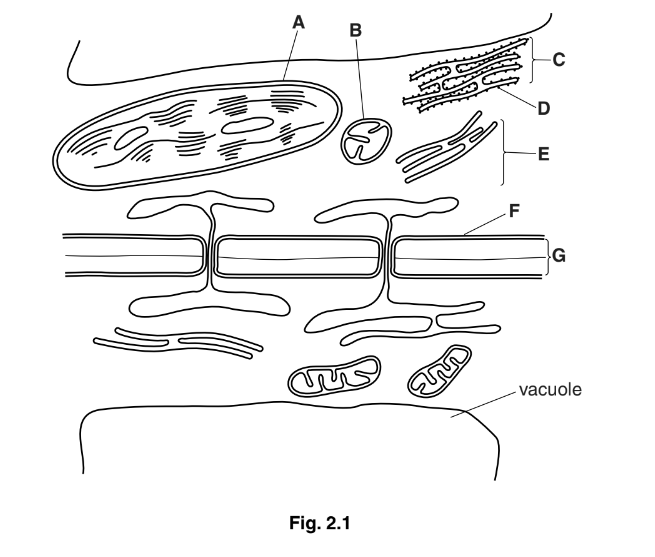
(a) Structures A and B are both visible using the light microscope, but the internal detail of
these organelles shown in Fig. 2.1 is only visible using the electron microscope.
Explain why the internal details of structures A and B are only visible when using the
electron microscope and not when using the light microscope.
(b) Name in full the structures labelled C, D and E.
(c) State one role of vacuoles in plant cells.
(d) Structures F and G have very different permeability properties.
Explain how the composition of structures F and G determines the permeability
properties of these structures.
(e) Fig. 2.1 shows two plasmodesmata connecting the adjacent cells.
Describe the roles of plasmodesmata in transport in plants.
Answer/Explanation
Answer: 2 (a) 1 electron microscope has, higher / AW, resolution (than LM) / ora ;
2 explanation of resolution as ability to differentiate between two points (close together) ;
3 ref. to (internal) membranes (of A and B) which cannot be seen in LM ;
A named membranes e.g. cristae, grana
4 AVP ; e.g.
(resolution of) EM is 0.5 nm (0.0005μm) and LM is 200 nm (0.2μm)
A 0.5 to 1 nm (0.001μm)
resolution is equal to half the wavelength (of medium used)
ref. to shorter / AW, wavelength (of electrons) / ora (must have a comparison)
ref. to, width of membranes / distance apart of membranes, e.g. width of membranes
in A and B is 7 nm (+/– 1)
2(b) C – rough endoplasmic reticulum ; penalise once only for ER instead of endoplasmic
reticulum
D – ribosome ; A ribosomes ignore 70S
E – smooth endoplasmic reticulum ; A smooth ER if full term used for C
award one mark if E = rough endoplasmic reticulum and
C = smooth endoplasmic reticulum
2(c) any one relevant e.g.
store of / holds, cell sap ; R if contains organelles
store of / holds, water / ions / named ion(s) / minerals / salts / pigments / (named) sugars ;
R substances / molecules
R storage unqualified
pushes chloroplast to edge of cell ;
gives, turgidity / turgor pressure / hydrostatic pressure / support / AW ;
A makes, firm / rigid
A controls / maintains, turgidity
R gives shape / strengthen
store of / holds, waste (products)
R reactions occur in vacuole, unqualified
2(d) no marks for identifying F and G
if only F or G described max 3
if F and G incorrectly identified, accept mark points correctly linked to membrane and wall
to max 3
1 F partially permeable A selectively permeable
and G (fully / freely / AW), permeable / porous ;
F is partially permeable cell surface membrane
2 phospholipid (bilayer);
3 permeable to, lipid-soluble molecules / oxygen ;
A other terms for lipid-soluble
treat reference to water as neutral
4 impermeable to, water-soluble / AW, molecules / ions / AW ;
A other terms for water-soluble
treat reference to water as neutral
5 aquaporins / proteins, provide (increased) permeability to water ;
6 transport proteins provide permeability to, ions / polar molecules ;
A channel / pore / carrier, proteins
G is permeable cell wall
7 cellulose ;
8 fibres ;
9 ref. to, spaces / gaps / holes / pores, (between, fibres / other cell wall
components) ; [max 4]
2(e) 1 allows transport of, water / sucrose / amino acids / organic substances / ions /minerals /
salts / lipids / hormones / ATP, (from cell to cell / between cells) ; R if linked to an incorrect transport mechanism e.g. sucrose moves by osmosis
2 without crossing, membranes / walls ; A without going through protein channels
3 this is movement through the symplast ;
4 any e.g. ; companion cell to (phloem) sieve tube (element / cell)
between mesophyll cells
mesophyll cell to companion cell
cortical cell to cortical cell / across cells of the cortex
cortical cell to endodermal cell
endodermal cell to, pericycle cell / xylem / phloem
ignore between sieve tube elements
5 allows, communication / signalling, between cells ; [max 3]
Question
Fig. 1.1 is a drawing made from an electron micrograph of a mammalian liver cell.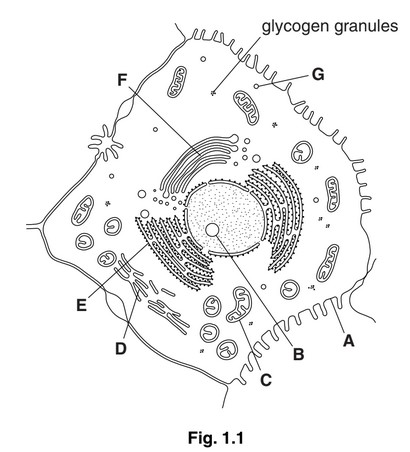
(a) Complete the table by naming the structures B to G and stating one function of each.
The first one (A) has been completed for you.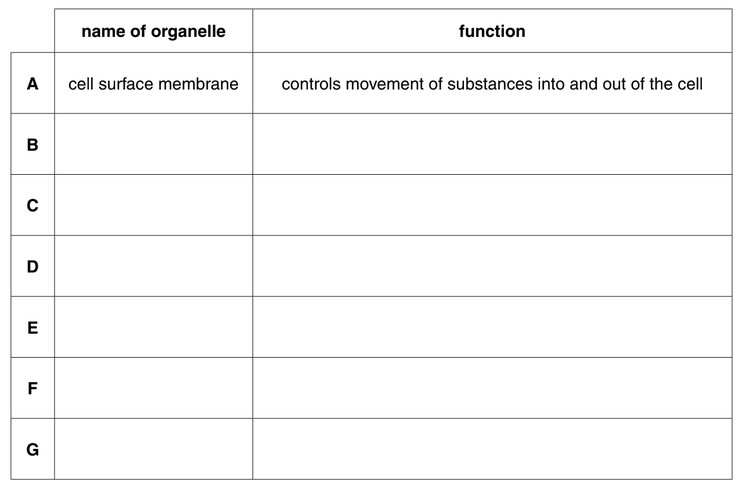
(b) As shown in Fig. 1.1, liver cells contain many storage granules of glycogen.
Describe the molecular structure of glycogen and explain how this structure makes it
suitable for storage.
Answer/Explanation
Answer:
(a) one mark per row
penalise once for stated ecf and then mark to max 4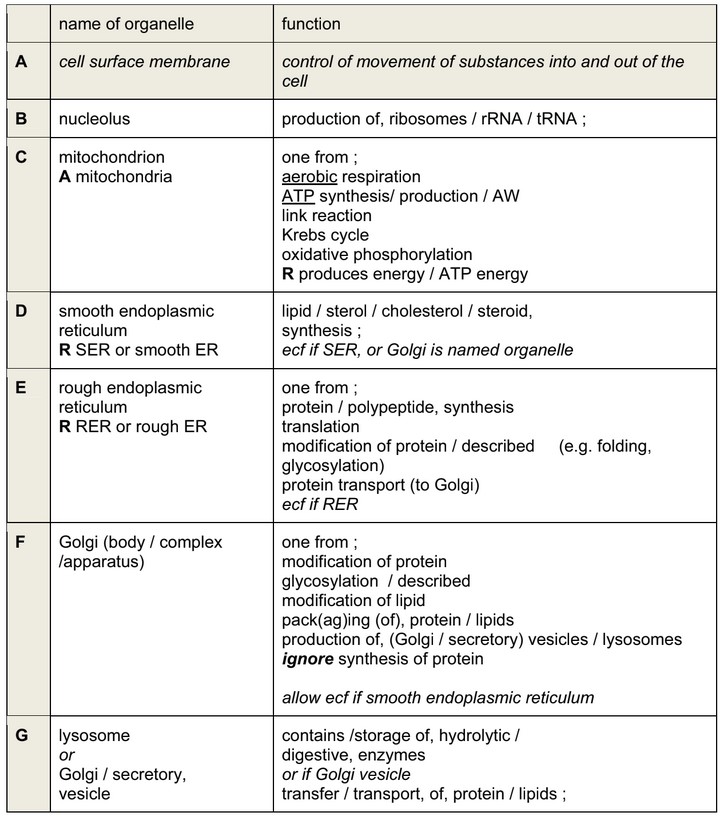
(b) max 3 if only structure or only explanations given
polysaccharide ;
chains of α-glucose (residues) ; only need α once
α1–4 glycosidic bonds / links ;
branches ;
(because of) α 1–6 glycosidic bonds ; only need glycosidic once
idea that many ‘ends’ to easily, add / remove, glucose ;
compact / AW ;
insoluble ;
will not affect, water potential / ψ ; AW
AVP ;
Question
Cholesterol is synthesised in the smooth endoplasmic reticulum (SER) in liver cells by a series of enzyme-catalysed reactions.
Within the SER, molecules of cholesterol and triglycerides are surrounded by proteins and phospholipids to form lipoproteins. These lipoprotein particles enter the Golgi apparatus where they are packaged into vesicles and pass to the blood.
Fig. 4.1 is an electron micrograph of part of a liver cell showing lipoprotein particles within the Golgi apparatus.
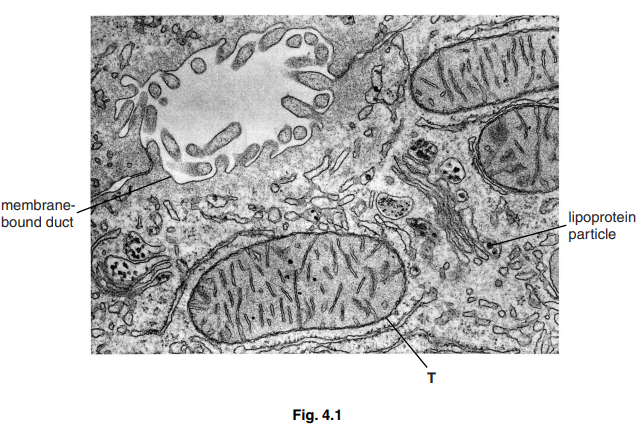
(a) Name structure T in Fig. 4.1 and state its role in liver cells.[3]
(b) (i) Suggest why cholesterol is packaged into lipoproteins before release from liver cells into the blood.[1]
(ii) Explain why cells of the body need to be supplied with cholesterol.[2]
(c) Cholesterol is also packaged into vesicles by the SER and then secreted from the cell into small fluid-filled spaces between the liver cells. These spaces form ducts that drain into the gall bladder to form bile.
Suggest how cholesterol is secreted into ducts, such as the duct in Fig. 4.1.[2]
(d) State one function of the Golgi apparatus other than the packaging of substances into vesicles for transport.[1] [Total: 9]
Answer/Explanation
Ans:
4 (a) 1 mitochondrion ; A mitochondria
A outer mitochondrial membrane
2 produces / synthesises /AW, ATP ; A release/ supply, ATP/ energy
R produces energy
R ATP energy
or
for outer mitochondrial membrane allows exit of (synthesised) ATP to cell
3 example of use of ATP in liver cells ;
e.g. for synthesis of, cholesterol/ glycogen/ protein/ biological molecules / polymers / AW
intracellular movement of vesicles
exocytosis / endocytosis / bulk transport
active transport
(b) (i) lipoproteins are soluble ;
cholesterol is not water-soluble ;
cholesterol surrounded by / lipoproteins have, phospholipid heads /proteins, that are hydrophilic ; AW
allows transport in blood ;
(ii) cholesterol needed for
making/ components of, membranes ;
membrane stability ;
regulating the fluidity of, membranes /phospholipid bilayer ;
production of, steroid hormones /named steroid hormone ;
AVP ; e.g. helps prevent entry of, ions / polar molecules
(c) vesicles travel to cell surface membrane ; A travels through cytoplasm towards space between cells
exocytosis ;
vesicle/ membrane, fusion (with cell surface membrane) ;
contents / cholesterol, released ;
(d) glycosylation/ adding sugar molecules to proteins / making glycoproteins ;
A modifying proteins
phosphorylating proteins ;
cutting/ folding, proteins ;
assembly of polypeptides into proteins (with quaternary structure) ;
AVP ; e.g. lipid synthesis
ref. lysosome formation
